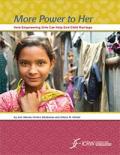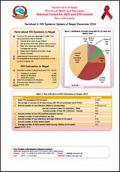What's New
Displaying results 3161 - 3170 of 4914

Resource | Publications,
Reproductive health is fundamental to individuals, families and the social and economic development of communities and the nation.
The goal of this strategy is to develop the health sector to improve the health of the people of Maldives, especially women and children. This document provides a template to develop specific plans and to make funding decisions. It also emphasizes that ensuring the health of women and children involves a cross-sectoral approach whereby Ministry of Health must work with sectors outside of Reproductive health.
All interventions for Reproductive health should be made available with the highest standard of quality and safety, and services should be delivered according to evidence-based best practices. Addressing needs and community views, particularly those of women, on the quality of service provision is key to ensuring improved quality and increased access and utilization at all levels. Involvement of communities can improve acceptance to health services.

Resource | Publications,
There are nearly 70 million child brides in the world today, and more than 15 million girls marry each year. Around the world, there are a number of programs and many organizations that are working to prevent child marriage and provide support to married girls.
Through the assessment of four promising programmes run by CARE (Ethiopia), BRAC (Bangladesh), Save the Children (Egypt) and Pathfinder International (India), the paper highlights the critical role that girl-centred programming plays in catalysing a process of empowerment that enables her to make important decisions that affect the rest of her life – including when and whom to marry.
Successful programmes were found to catalyse empowerment by allowing girls to undergo an internal transformation by building their self-awareness of rights, increasing their self-efficacy and enhancing their life aspirations. Increasing opportunities and alternatives to child marriage aids this self-transformation.

Resource | Publications,
The Ministry of Health developed the National Strategic Plan for Reproductive Health in Myanmar (2014-2018) to ensure an effective and coordinated response to reproductive health needs in the country. This strategic plan and upcoming operational plans provide the framework from which to advocate reproductive health priorities, engage in annual planning, and mobilise the resources necessary for effective action.
The strategic Plan on Reproductive Health builds on a initiatives undertaken to serve the health needs of the population of Myanmar. Included among these are the National Population Policy (1992), the National Health Policy (1993), which was followed by formulation of the Myanmar Reproductive Health Policy (2002). The National Comprehensive Development Plan - Health Sector (2010-2011 to 2030-2031) and the National Health Plan (2011-2016) are the overarching frameworks for the Strategic Plan on Reproductive Health (RH).

Resource | Fact Sheets,
-The first HIV case was detected in 1988. The key populations are as follows:
People who inject drugs (PWID)
Sex workers and their clients (Male and Female)
Men who have Sex with Men (MSM) and transgender people
Male Labor Migrants and their wives
Prison Inmates
- Heterosexual transmission is dominant
- HIV prevalence among adult population in the country is below 1%

Institutional Mapping Study of Social Protection Schemes in the Province of Khyber Pakhtunkhwa, 2013
Resource | Publications,
An increase in poverty is a palpable phenomenon throughout Pakistan especially in the Khyber Pakhtunkhwa (KP) province. This perception seems to be supported by the World Development Indicators (WDIs) 2013 report which states that “Sixty percent of Pakistan's population is living below the poverty line” according to the US two dollar per day poverty measure. The poverty in Khyber Pakhtunkhwa (KP) may be attributed to a decade of militancy, insurgency and terror-related activities, compounded by natural disasters such as floods.
This mapping study presents the findings from an extensive review of the literature on social protection literature produced during the last seven years. It is also informed by a survey conducted in all the districts of Khyber Pakhtunkhwa between April and to June 2013. The study was commissioned by the ILO Pakistan.

Resource | Tools,
This handbook was written by a team of legal experts and reviewed by community activists working for improving the human rights situation of people with HIV and key populations most at risk of HIV. It is intended for people with HIV, people who are at higher risk of HIV, as well as their partners and family members.
The handbook describes, step by step, how to behave when a rights violation occur, how to document it and how to seek help – directly from the authorities, or with the free help of legal professionals. It is supplemented by a set of user-friendly forms and free legal aid contracts. This handbook was designed for the legal systems of the countries in Eastern Europe and the CIS.

Resource | Publications,
The Maternal Health Thematic Fund is UNFPA’s flagship programme for accelerating improved maternal and newborn health and the only one of its kind in the UN system that focuses on a key area of reproductive health while intensively contributing to strengthening health systems. The MHTF enables a targeted response to maternal mortality and morbidity across several dimensions, using sound evidence and state of the art knowledge while contributing to build the capacity of countries to create a functioning health system.
This annual report highlights the Fund's critical contributions in 2014: from the training of 16,000 midwives, to supporting 10,000 surgical fistula repairs, to the finalization of national surveys on emergency obstetric and neonatal care, to South-South collaboration to improve maternal death surveillance and response, to the piloting of activities for first-time young mothers, a new focus area for the Fund.

Resource | Publications,
This 73-page report documents government abuses against transgender people in Malaysia. In research in four Malaysian states and the federal territory of Kuala Lumpur, Human Rights Watch found that state Religious Department officials and police regularly arrest transgender women and subject them to various abuses, including assault, extortion, and violations of their privacy rights. Religious Department officials have physically and sexually assaulted transgender women during arrest or in custody, and humiliated them by parading them before the media.

Resource | Guidelines,
The publication aims to provide national statistical offices with detailed guidance on how to collect, process, disseminate and analyse data on violence against women. It lays out the role of statistical surveys in meeting policy objectives related to violence against women, the essential features of these surveys, the steps required to plan, organize and execute these surveys, the concepts that are essential for ensuring the reliable, valid and consistent measurement of women’s experiences in accordance with core topics and a plan for data analysis and dissemination.

Resource | Publications,
The 2014 Annual Report provides an overview of UNODC's work across the globe in assisting Member States to address the threat posed by drugs, crime and terrorism. In addition to highlighting the Office's achievements for the year, it showcases the human impact of UNODC's work through a series of success stories and the effect on the ground.
The Annual Report covers a wide-range of content, including: a forward-looking strategic narrative that places UNODC's efforts within the evolving global policy landscape and sketches broad priorities for the coming few years; thematic chapters on drugs, health and trafficking; transnational organized crime; justice; corruption; terrorism; policy support and public affairs; research, trend analysis and forensics; and independent evaluation; and information on the Office's finances and funding.





